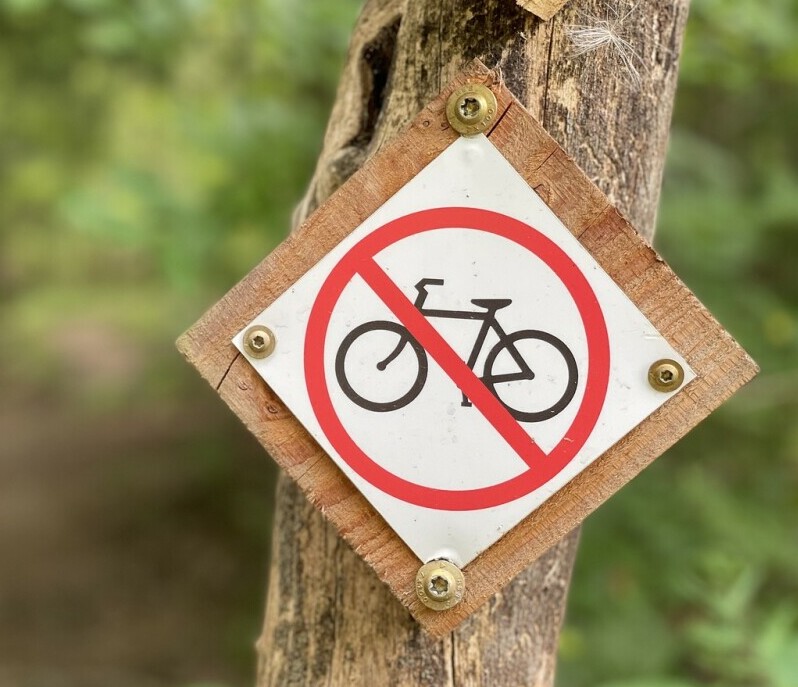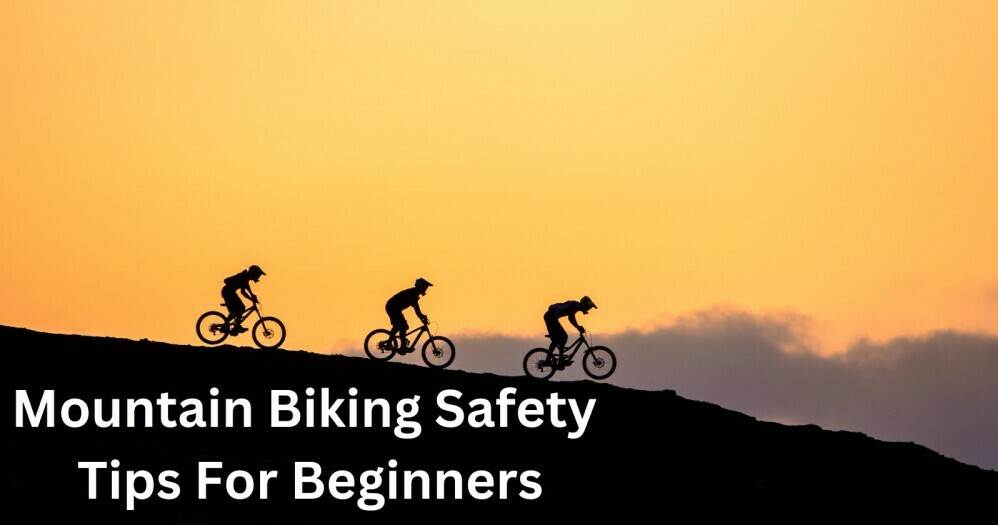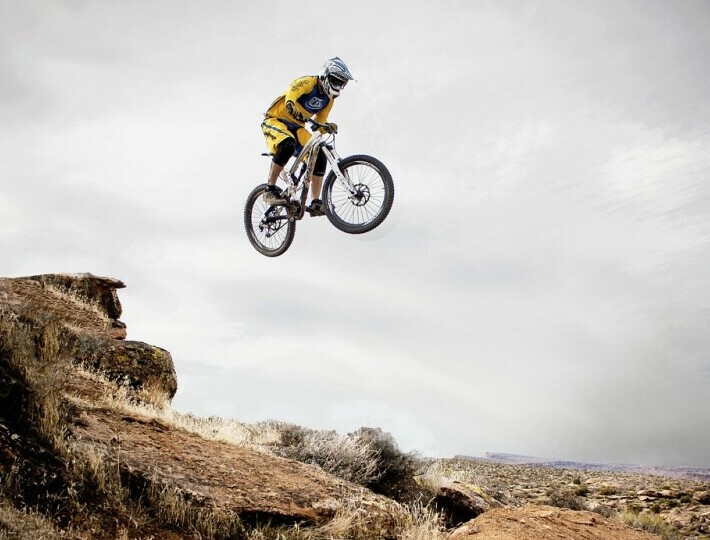
Let’s look at some mountain biking safety tips for beginners, because let’s face it, this can be quite dangerous and is not for the faint-hearted!

I’m going to kick things off by emphasizing how crucial the right equipment is for mountain biking.
A well-fitted helmet isn’t just a suggestion – it’s a must. It protects your most valuable asset, your brain. Helmets designed specifically for mountain biking offer better coverage and protection for the back of your head, which is more prone to injuries in off-road spills.
It’s also about selecting the right mountain bike, which is key to your overall riding experience. It’s not just about the looks; the size, suspension, and tire tread all play significant roles in how your bike handles varying terrains and challenges.
You will also need to think about gearing up with protective gloves, pads for knees and elbows, and eye protection to guard against flying debris. These are essential not just for comfort but for reducing the severity of injuries should you take a tumble.
Choose something that resonates with you when it comes to clothing: breathable, moisture-wicking fabrics are your friend on the trail. They keep you cool and dry, while also providing a barrier against scrapes. And don’t forget the importance of cycling shoes with good grip, as they connect you to your pedals.
Lastly, a quick maintenance check can prevent accidents caused by equipment failure.
Ensure your brakes are responsive, your tires have enough tread and are properly inflated, and your suspension is working correctly. Regular checks and tune-ups are your first line of defense against mechanical issues.
Good equipment is only half the battle. Knowing how to prepare for a ride and having essential biking skills are what truly help you stay safe on the trails.
Pre-Ride Preparation Mountain Biking Safety Tips
Before you even hit the trail, prepping your ride is key.
Take a few minutes to inspect your bike.
Make sure the brakes are responsive, the tires have the right amount of pressure, and all the components are secure. This isn’t just about avoiding mechanical failures; it’s also about making sure you can rely on your bike when you need it most.
Understanding the core skills of mountain biking is crucial for your safety. I’m talking about the ability to balance, steer, brake, and shift gears smoothly. These are your bread and butter on the trail.
If you want to, consider taking a class or practicing these fundamentals in a safe, controlled environment before tackling more challenging terrain.

Trail etiquette is something you might not think about, but it’s vital. This means understanding the right-of-way on the trail, being mindful of nature, and sharing the space respectfully with others.
When everyone follows these unspoken rules your ride will be that much smoother.
You can always adjust your approach down the road, but start by choosing trails that match your current skill level. Trail difficulty ratings exist for a reason, and biting off more than you can chew isn’t just bad form—it’s dangerous. Don’t worry too much about keeping up with more experienced riders, rather focus on building your skills at a pace that’s right for you.
Finally, pacing yourself is a smart move. Mountain biking is an endurance sport, and burning out too quickly can lead to mishaps on the trail.
Recognize the signs of fatigue, and allow yourself moments to rest and recover. This isn’t a race (unless, of course, it is), so take the time to enjoy the ride and the beautiful scenery.
Mountain Biking Safety Tips For Beginners On Trail
Now, it’s time to focus on how to stay safe WHILE YOU’RE RIDING. Maintaining safety on the trail is a mix of vigilance, good decision-making, and respectful riding habits.
First off, keeping your eyes and ears open can’t be emphasized enough. That means BEING AWARE of your surroundings, anticipating possible obstacles, and staying ready to react. This will help you avoid potential hazards and ensure you’re not caught off guard.
When it comes to tackling turns and descents, confidence is key. Use the skills you’ve practiced to navigate these trickier parts of the trail. CONTROL YOUR SPEED and position your body for better balance, and you’ll find these maneuvers less daunting.
It’s also important to know HOW TO FALL. No one likes to think about it, but falls happen, and knowing how to do so safely can greatly reduce your risk of serious injury. Tuck and roll away from your bike—if you can do it safely.
Don’t forget hydration and energy replenishment. Your body is like an engine that needs fuel. Carry water and snacks, and USE THEM BEFORE you’re feeling depleted.
Regular breaks can also help maintain your energy levels.
Lastly, know WHEN TO CALL IT QUITS. There’s no shame in cutting a ride short if you’re feeling fatigued or notice any pain. Recognizing these signs early on can prevent minor issues from developing into more serious injuries.
I hope that you find these mountain biking safety tips for beginners helpful for your next mountain bike ride. Remember, staying safe isn’t just about self-preservation; it’s also about enjoying the trails for many more rides in the future.

Hi Michel,
Your post is fantastic since it offers new riders priceless advice on mountain biking safety. It emphasizes the need for proper gear, such as a properly fitted helmet, and protective clothing, such as gloves and pads. It also highlights how important it is to check your bike before a ride, know the fundamentals of mountain biking, and follow trail etiquette.
With the thorough safety advice provided, a crucial query emerges: How can novice mountain bikers strike the right balance between the sport’s excitement and challenge and the necessity for safety, particularly when tackling more challenging trails for the first time?
Michael, thank you for this sound advice from a clearly experienced mountain biker. I love cycling and have done some mountain biking in mountainous areas such as the French Pyrenees and the Lake District in North-west England. I think you have touched upon the mindset you need for longer treks along with practical measures you should take.
This would be a great article to introduce casual cyclists who want to graduate to off-road cycling! They certainly are very different styles.
A thorough prep for serious biking.
Blessings and Success.
PS: it would be great if your recommended some equipment to research complete with in-depth reviews.
Thank you Linden. Will do in a future post.
Thank you for sharing these valuable mountain biking safety tips. My younger brother is an avid mountain biker, and has been a few bumps, bruises and the occasional broken bone.
It’s essential to prioritize safety, especially for those new to the sport. I appreciate the emphasis on proper equipment, pre-ride preparation, and on-trail practices.
I’m curious about the specific types of trails that beginners should start with. Could you provide some guidance on choosing trails that match skill levels?
Additionally, you mentioned knowing how to fall safely. Could you elaborate on some techniques or resources beginners can use to learn this skill?
Hi Heather,
As far a beginner trails go, most courses have clear markers for beginners and more advanced riders.
This may help when it comes to falling safely. Safely falling over the handlebars requires nimbleness and a quick reaction time. When headed over the front of the bike, get your body up and over your bars as soon as possible. This can be done by leapfrogging the handlebars or tossing your bike to the side as you jump over the frame.